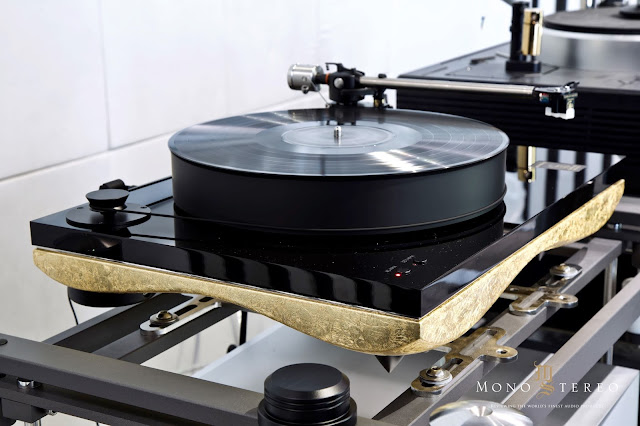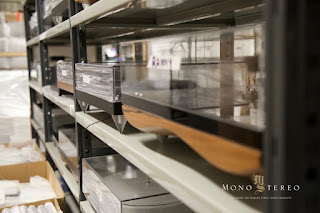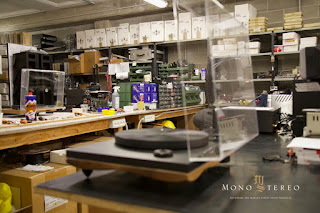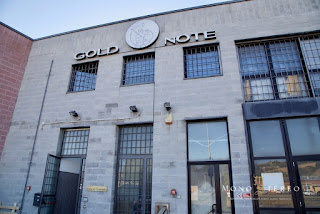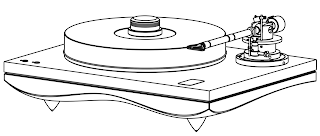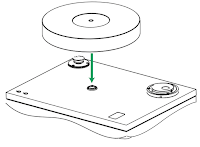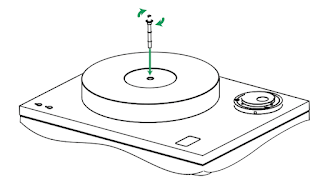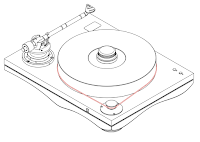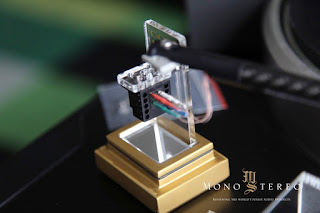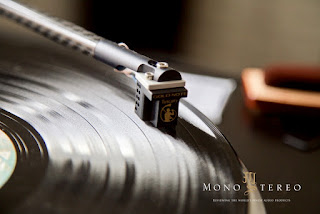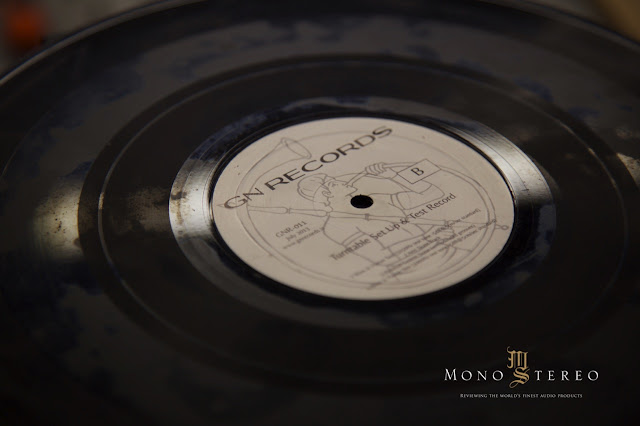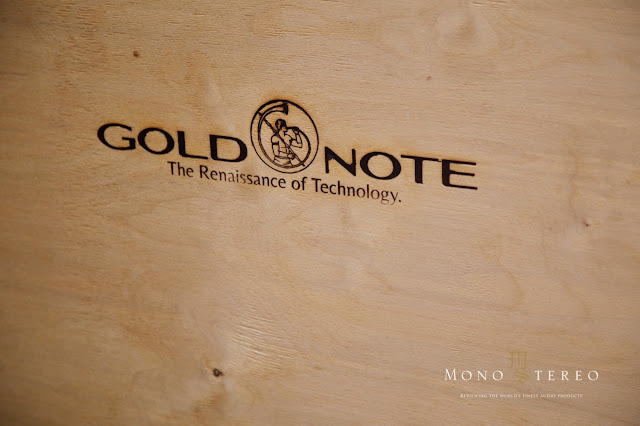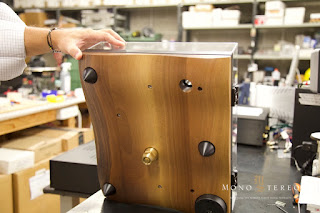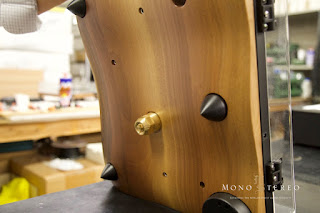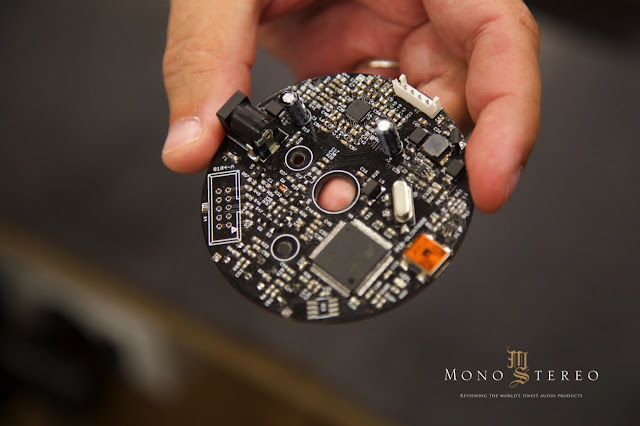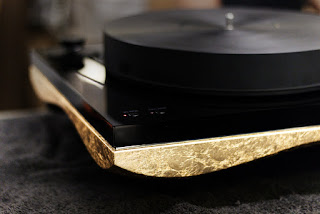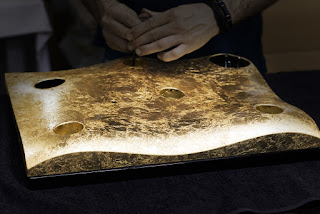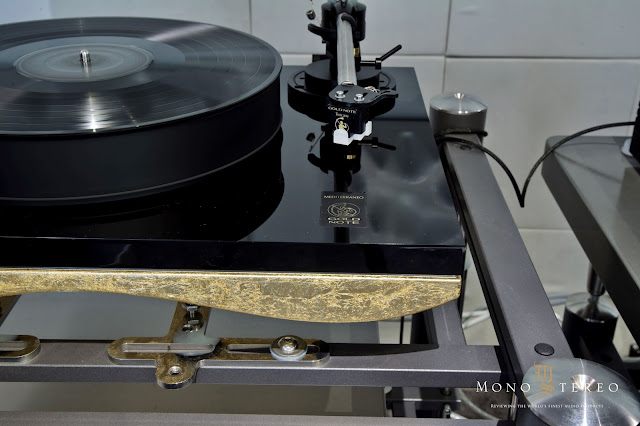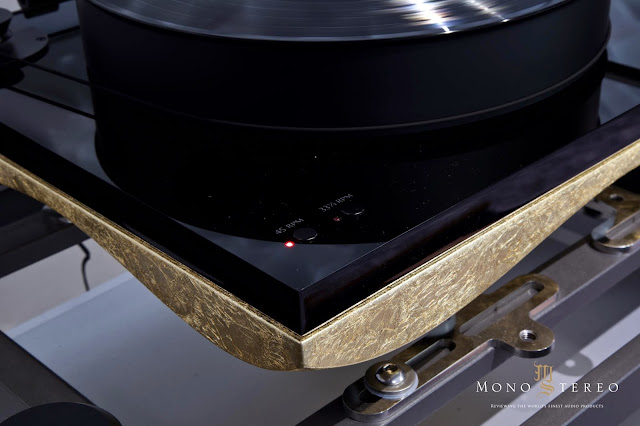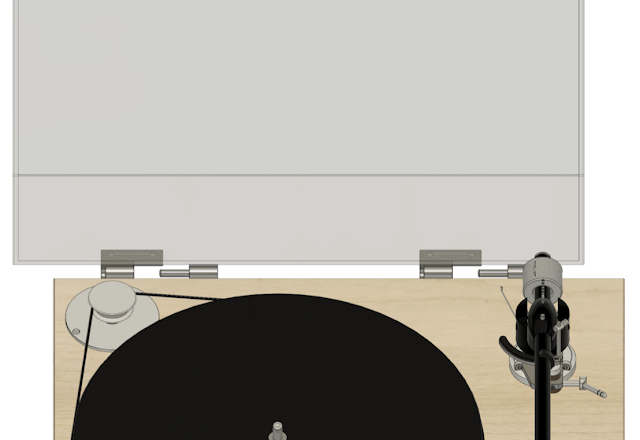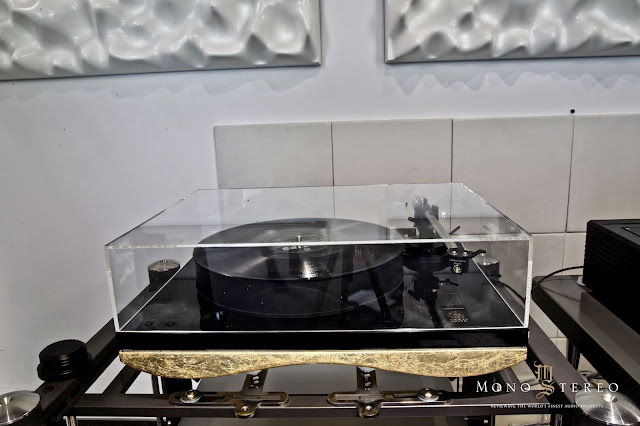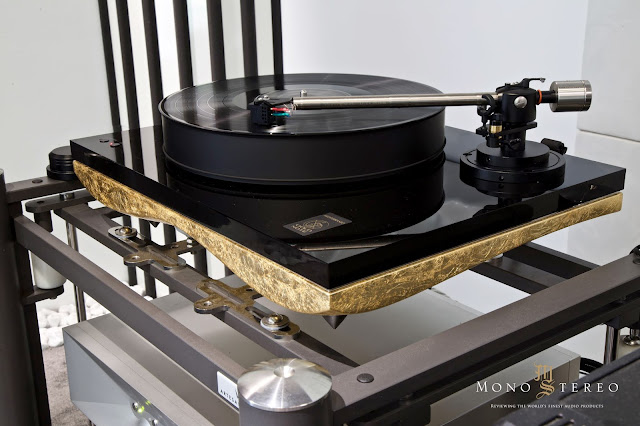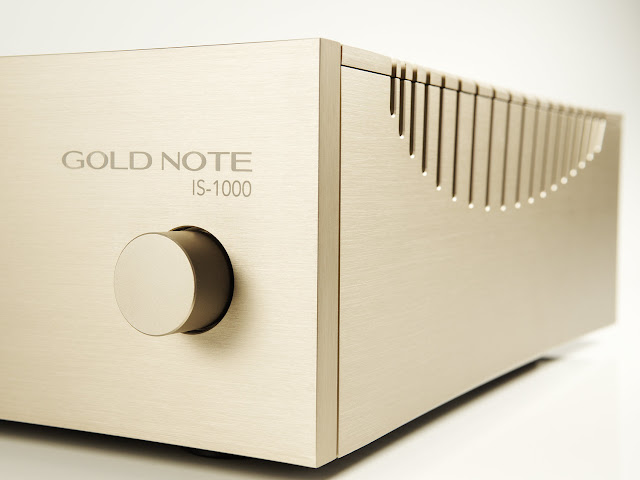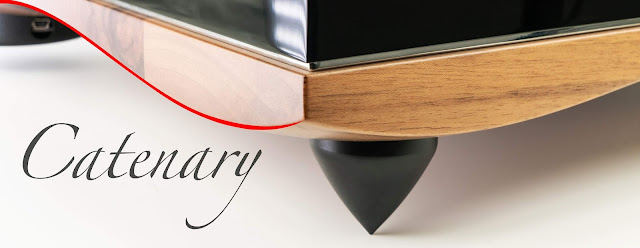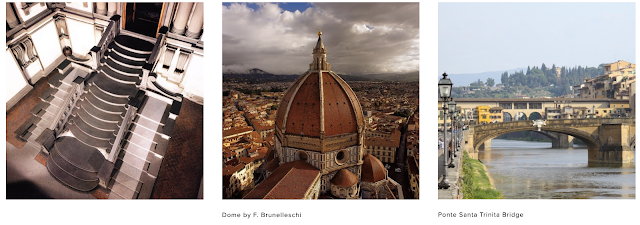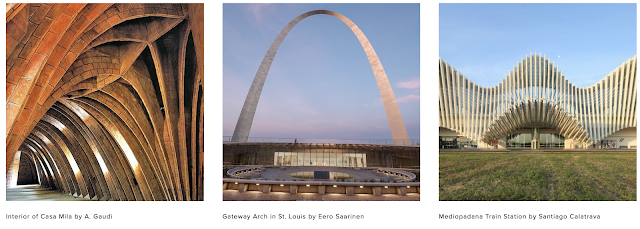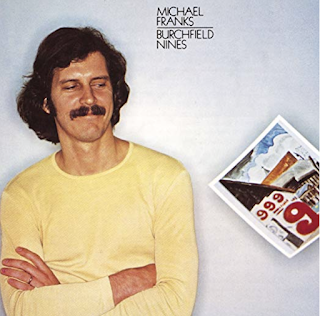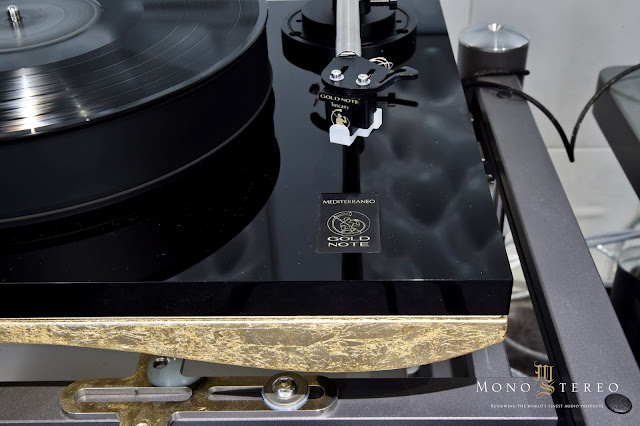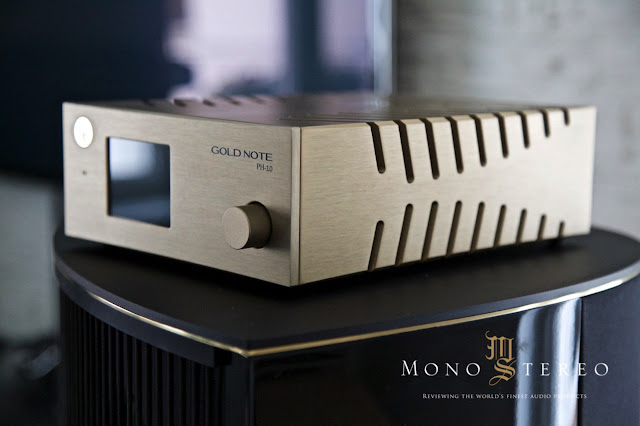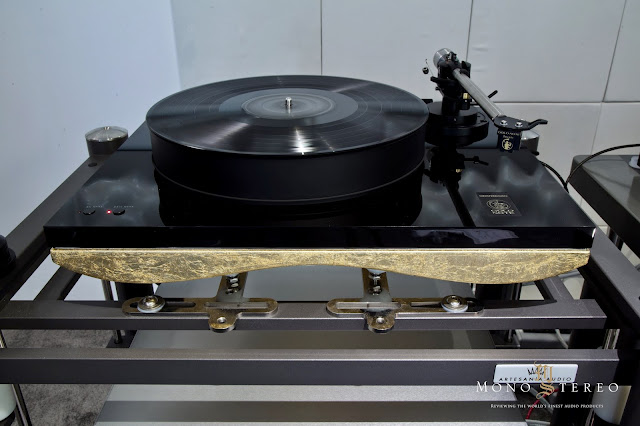Those of you who follow my venture for some time, know that I highly appreciate Gold Note high-end audio manufacturer from Italy. But I do not only cherish the brand, that has under the baton of visionary Maurizio Aterini managed to achieve an important and inspiring position at the high-end audio market. Their clear focus and dedication of creating genuine Italian products go beyond typical norms. This is shown by their latest brand’s media output, where they’re sensibly presenting the company’s core qualities and the efficacious Italian DNA, that is evenly severed across the complete product portfolio.
Some claim that analog is in the revival momentum, others firmly believe how the records never went out of fashion. Nevertheless, the present interest for analog is not to be neglected for various reasons. An appreciation for vinyl records invites new people to our beloved, but niche industry and we need products that are adding an extra value that is appreciated by the people that are not accustomed to the high-end audio products.
The subject of an analog front end is often brought up in my conversations and correspondence. With the newly introduced music lovers, more and more people are in search for a trouble-free, synergistic analog front end approach without too much hassle and complications, but of a stand-out quality.
Consequently, with the rise of the records sales, we’re witnessing fresh new blood of music enthusiasts, that recognize higher quality products and upper-level sonic reproduction, yet they might neither have time or will do go through the complicated turntable based setup.
At my last visit to the Gold Note factory, I’ve proposed the idea of a complete Gold Note package to the Maurizio Aterini – (Gold Note Founder & CEO) and he liked the idea. After my return, we’ve set the review schedule with a Gold Note’s swiftly Marketing/Communications Manager Marie Greggers and a few weeks later the analog package arrived at Mono and Stereo headquarters.
The analog package setup up included beautifully looking Mediterraneo in a gold foil finish, B-7 Ceramic tonearm and the Mono & Stereo Editor Choice awarded Tuscany Gold cartridge.
As I’ve requested everything was pre-set (the cartridge and tonearm) so that I’ve would go through the same experience as a customer without in-depth knowledge about the record players and associated paraphernalia.
Following the enclosed manual, the setup was easy, trouble-free and most importantly easy enough that won’t scare any of the novices away…
After about 15 minutes of careful setup, the full-blooded Gold Note analog ensemble was ready to play.
I’m using Gold Note Tuscany daily as my reference cartridge, so there were no extra efforts needed to get expressly familiar with it. The two unknowns included in this analog package setup up were beautifully looking Mediterraneo and B-7 Ceramic tonearm.
Before touching the aural amenities let me address the technical sides of these two. It’s needed to highlight many of the technical features that might otherwise escape the readers’ attention.
MEDITERRANEO
Gold Note nucleus is most intimately connected with analog, looking back at almost thirty years of R & D. It might not be immediately evident how much efforts and time went into the Mediterraneo project and Gold Note’s turntable platform design.
Mediterraneo is an epitome of the pure Italian spirit. But not only that. It’s also a technically profound record player. Aterini and Gold Note team have spent an immense time to hide all of the technical proficiencies under the highly chic outer shell.
THE ITALIAN TURNTABLE
Gold Note journey started 25 years ago looking back at the design of their very first turntable. Because of their deep affection and love for analog and a real passion for vinyl, these emotions define all of Gold Note creations and particularly turntables, driving the brand to design with great care and attention every single detail to create the most fascinating source of music.
Mediterraneo is the pinnacle of Gold Note: a creation that redefines the traditional design of turntables through innovative shapes, technical solutions and quality materials to merge tradition and technology and achieve the best musical experience.
Mediterraneo shows Italian flair and distinction in its strong Tuscan origins, combining beauty with the greatest attention to technical perfection.
Manufactured by local craftsmen, the Mediterraneo is fully hand-made: designed with a 60mm curved plinth made of aged Italian Walnut chosen for its exceptional elasticity, strength, and high-density, then coupled with a 20mm board made of polished acrylic and finally reinforced with a 3mm stainless steel board to lower the frequency resonance.
Every detail of Mediterraneo enhance the turntable’s ultra-rigid structure, the result is a refined technical innovation achieved through elegant, smooth lines.
BEAUTY AND INNOVATION MERGED IN ONE CREATION
The Power Supply of the 12 Volt Swiss Made synchronous motor of Mediterraneo guarantees the best audio performances. Electronic 33/45rpm controls and fine speed adjustments are automatically stored in the controller memory even when the turntable is unplugged from the AC.
Thanks to Gold Note proprietary power control generator based on Quadral-Core micro-controller, Mediterraneo can reshape the AC wave and minimize all vibrations while improving torque power for the greatest dynamic and resolution.
The new hourglass-shaped pulley made of polished aluminum allows the belt to spin as smoothly as possible, reducing the Wow&Flutter and the Rumble to extract and enjoy the finest details from the groove.
The 60mm platter Spindle/Bearing system is made with superior materials: the best-hardened chromed steel, polished bronze housing and ceramic ball bearings, all to guarantee a fantastic audio performance and ultra-low noise.
The recessed platter bearing, housed into the acrylic board, keeps the platter as close as possible to the structure increasing rotational stability and speed precision.
With a 45mm high-mass-platter made of black Sustarin – a special material based on POM polymer, rigid but highly dampening at the same time – Mediterraneo is an extraordinary efficient in reducing vibrations and preserving great rotational stability.
DAMPENING STRUCTURE WITH TRIPLE PLINTHS
Mediterraneo has a multiple plinth design that features a 60mm wooden base in Italian Walnut hardwood slats and a 20mm board in polished Acrylic. The structure is reinforced by a 3mm thick stainless steel board to improve its exceptional dampening quality and stability. The plinth is available in three classic Italian finishes: Walnut hardwood, Black Lacquered MDF and gold foil.
INNOVATIVE POWER CONTROL
Mediterraneo is powered by Gold Note best proprietary control system developed on Quadral-Core micro-controller and enhanced with an audio converter: this power control reshapes the AC wave to perfectly drive the 12V synchronous motor and cancel all vibrations while improving motor torque to deliver the greatest dynamic and the finest detail.
HIGH MASS & DEAD DESIGN PLATTER
The high precision 45mm platter made of Sustarin and the bearing/spindle system are perfectly matched with ultra-strict tolerances. The spindle is made of rectified hardened and chromed Steel, the 4,3mm bearing is made of ceramic. These materials guarantee the best and smoothest rotation lowering, even more, the noise.
HIGH PRECISION SYSTEM
Featuring 60mm long platter bearing/spindle with the best coupling tolerance available on the market: the spindle is made of the hardest carbon rectified steel hardened to achieve perfect working fluidity.
The bearing system is made of polished bronze with a 1/100 mm tolerance to guarantee the smoothest platter rotation.
SMART BUNDLE
Ready to play out of the box, the bundle includes a dedicated Gold Note B-5.1 tonearm and a transparent custom hand made acrylic Dust Cover (easy to remove with our proprietary hinges). Also included in the package the high-quality external power supply PST-1, with grounded IEC plug allows using the favorite AC power cord in order to ideally tune the audio performance.
B-7 CERAMIC TONEARM
A well-designed tonearm should perform at its best with every cartridge while keeping things simple and effective, being easy to install and use. Add quality materials and elegant looks and you’ll have B-7 Ceramic.
Inside B-7 Ceramic you’ll find four high precision micro-ceramic ball-bearings manufactured in Germany by GRW, these ball-bearings are treated singularly and sealed to preserve their integrity and extreme precision, a crucial factor to enable noiseless functionality to let you enjoy every single nuance in your records.
B-7 Ceramic effective length of 242mm with 19mm overhang makes it easy to install on any turntable. The Azimuth is adjustable through a pair of 2mm micro bolts to set up the shell perfectly.
The rear arm wand is dampened with silicon spacer to reduce unwanted vibrations and handles a finely machined Stainless Steel counterweight to set up most phono cartridges (up to 15-gram mass).
The vertical ultra-low friction ceramic ball-bearings are pivoted through stainless steel bolts manually adjusted, the horizontal movement is driven by two micro ball-bearings directly inserted in the main rectified pivot.
With a 23mm diameter arm shaft, B-7 Ceramic can be secured on every turntable, improving performances and everyday pleasure.
THE CATENARY CURVE
There are many unique features connected with the Mediterraneo turntable, but one that is particularly interesting and intriguing is catenary curve. So what is it and why it’s so important and intimately connected with the Gold Note Mediterraneo turntable!?
The characterising element that combines the chassis of Gold Note turntables and electronics is the use of curved surfaces that in both cases enable creating very rigid structures. Structural rigidity is a key point to achieve better sound because it allows dampening vibrations and therefore limiting unwanted resonances. In Gold Note products, curves are not only a stylish element to give personality to the items, they also have a technical motivation since improving the sound performance.
In addition to all the traditional designs to get more rigid chassis, the guiding concept of Gold Note products is entirely inspired by the “Resistance by Form”, which in geometry always requires two operations:
1. The attribution of a curvature.
2. Removing material from the neutral geometrical plane.
Applying the curvature to a form that mainly recourses the Catenary curve, is a particular design obtained by a chain hanging on the two ends and loaded only by its own weight.
INNOVATIVE FORM FINDING
For the distinguished design of Gold Note „Italian Turntable“ series we introduced a “Physical Form Finding” calculation, in which a specific custom algorithm recreates the deformation of surfaces subjected to physical forces such as pressure and gravity.
The shape of the Mediterraneo, Giglio and Pianosa turntable plinths are therefore obtained by treating the surface like a sail of a boat, a geometry composed of Catenaries which is therefore entirely subjected to tensile stresses, that being turned upside down enhances the compression resistance getting the best structural rigidity.
STIFFENING QUALITIES
The Catenary curves are also present in all Gold Note electronics, in correspondence of the cooling cuts while the “Resistance by Form” concept is different compared to the one used for the turntables. In addition to the high standard solidity of the Gold Note electronic chassis made with thick and strong steel and aluminium panels, the lack of parallelism between the slots allows the damping of unwanted resonances while increasing the structure rigidity at the same time. In fact the milling cuts are designed with a Slipforming drawing in order to cancel the different frequencies resonating each other.
THE CATENARY CURVE’S HISTORY
RENAISSANCE FLORENCE: A SOURCE OF INSPIRATION
Also because we are from Firenze, for developing the Gold Note audio equipment we got inspiration from our history of art and particularly from the Renaissance, a great innovative time where art and the technology combined created timeless wonders. As it happened during the Renaissance we wanted to combine the best of two seemingly opposing worlds: contemporary innovation and consolidated tradition.
In the sixteenth century, Florence was the most important place for the original merge of fine arts with technology, the time where Filippo Brunelleschi created the wonderful dome of the cathedral of Santa Maria del Fiore, symbol of the city of Florence.
Here, the master artist and engineer Michelangelo Buonarroti, with a brilliant intuition, introduced the Catenary curve as first. For its beautiful shape and for its unique structural qualities, Michelangelo made some of his extraordinary works using the Catenary curves such as: the staircase in the vestibule of the Laurenziana Library and the Santa Trinita Bridge that crosses the Arno river next by the Ponte Vecchio Bridge.
Michelangelo designed the arches of his bridge with a perfect shape introducing the Catenary for the first time at all when all mathematical features about it were completely unknown. Gold Note designer Architect Stefano Bonifazi was inspired by the genius of Michelangelo for designing all Gold Note products.
A MATHEMATICAL CHALLENGE
Few years later Galileo Galilei was the first to mathematically develop the Catenary curve in his first description of it on the second day of the “Dialogues Concerning Two New Sciences” (published posthumously
in 1638) as a solution to a static problem: “how to saw a supporting beam to lighten it without compromising its resistance”, correctly asserting that the beam evolution should look as a reversed chain hanging from its ends. Galileo originally seemed to assign this as it was a Parabolic curve design. In reality, reading also what he says on the fourth day of his writings, Galileo is aware that the Parabolic and the Catenary curves are only similar, the Parabolic word was used as an approximation of the Catenary only. However, none of his contemporary scientists noticed it, calling that concept the “Galileo Error” becoming the subject of discussion among scientists across Europe.
Only in 1690 Jacob Bernoulli rediscovered the mathematical equation of Michelangelo and Galileo, while in 1691 the Dutch scientist Christiaan Huygens started solving the problem of the Catenary curve eventually described by Gottfried Wilhelm Leibniz and Johann Bernoulli, later becoming one of the most efficient curve used in many engineering and architectural creations, an extensive use of it is made by Antoni Gaudì in his works and and a more recent example is the famous Gateway Arch in St. Louis (U.S.) or the “Le vele di Calatrava” complex in Reggio Emilia (Italy).
photo courtesy disclosure: no copyright infringement intended
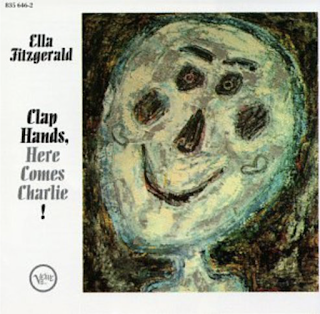 On this album, Ella Fitzgerald escapes the usual songbooks repertoire and larger orchestra setting with a smaller jazz band ensemble. This iconic album greatly captures the immortal classics and their renditions are fantastic, chiefly due to a great musicians’ interplay.
On this album, Ella Fitzgerald escapes the usual songbooks repertoire and larger orchestra setting with a smaller jazz band ensemble. This iconic album greatly captures the immortal classics and their renditions are fantastic, chiefly due to a great musicians’ interplay.
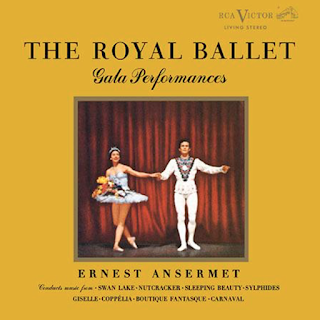 The Royal Ballet Gala Performances’ impressive wide-scale expanse is usually strictly reserved to the upper echelon turntables. Not so with the Gold Note Mediterraneo and accompanied apparatus. This particular pressing reveals closer to reality scope, that is It’s not about saturated flattering, but all about the realistic impact.
The Royal Ballet Gala Performances’ impressive wide-scale expanse is usually strictly reserved to the upper echelon turntables. Not so with the Gold Note Mediterraneo and accompanied apparatus. This particular pressing reveals closer to reality scope, that is It’s not about saturated flattering, but all about the realistic impact.
 Too often these days we’re can witness a wide variety of products with various technologies are being implemented for the sake of technology. This can easily results in a lifeless and bland sonic delivery that sparks little or no interest at all. On the contrary, the Mediterraneo delivers what promises and with the lasting impact.
Too often these days we’re can witness a wide variety of products with various technologies are being implemented for the sake of technology. This can easily results in a lifeless and bland sonic delivery that sparks little or no interest at all. On the contrary, the Mediterraneo delivers what promises and with the lasting impact.
THE MUSIC
It’s all about music with anything Gold Note related and Mediterraneo is no different in this regard. Over the weeks in evaluation, the Tuscany analog combination has proven to encompass all of the attributes that make the Gold Note so distinguishing.
In my extensive listening journals, there was one remark that frequently stuck out. The music flow! The smooth integration fo Mediterraneo, B-7 Ceramic and Tuscany Gold performed as I’ve expected; effortless and spontaneously engaging.
The mesmerizing intercommunication was constituted ad hoc! This was quickly identified with Michael Frank’s Burchfield Nines (1978, Warner Bros). Album was produced by Franks’s long-time friend and collaborator Tommy LiPuma and mixed by one and only Al Schmitt! It’s a rare gem that shows a mellower side of Franks at his best and with a sonic scenery that perpetually encourages revisits.
Coming from analog era Burchfield Nines is one of those albums that are designated to be played in the analog domain. There is something very ceremonial yet most highly enjoyable when Franks’s composing freedom under the Warner Bros is partnered with the analog realms.
To fully experience the album’s safe side of melancholy, the analog chain needs to be ready to let fragile energy from the cartridge come to life. With minuscule signal, anything can go wrong at every part of the signal path. This includes the cartridge, tonearm and tonearm’s cables, turntable, phono preamplifier, etc. Mediterraneo and associated setup revoke all of the needed properties for music to bloom candidly. It was a true pleasure to re-listen this highly familiar studio album. Mediterraneo never acted self-centering. Franks’ music was served punctually and lively. If the overall voicing of an analog front end is accented at any particular frequency, the Burchfield Nines becomes uninvolving and ready to skip. The Mediterraneo’s evenly distributed energy management has allowed intimate rendition. Powerful, sensuous and snappy!
The Mediterraneo, B-7 Ceramic and Tuscany Gold synergy and ability to convey palpable sonic canvas were further confirmed with the Clap Hands, Here Comes Charlie! by Ella Fitzgerald. Fitzgerald’s silky voice and upbeat tempo on were easily and promptly followed, escaping the variable pitch anomalies, that are too obvious even with some top tier turntables.
 On this album, Ella Fitzgerald escapes the usual songbooks repertoire and larger orchestra setting with a smaller jazz band ensemble. This iconic album greatly captures the immortal classics and their renditions are fantastic, chiefly due to a great musicians’ interplay.
On this album, Ella Fitzgerald escapes the usual songbooks repertoire and larger orchestra setting with a smaller jazz band ensemble. This iconic album greatly captures the immortal classics and their renditions are fantastic, chiefly due to a great musicians’ interplay.
Mediterraneo’s ability to convey Fitzgerald’s lustrous and melodic voice is of quality, that leaves many of the turntables disarmed with the much needed dense lushness. No matter the price tag this is not an undemanding task and the Gold Note, flagship turntable aptness to capture this vibrancy so abruptly is the sole attribute worthy of putting the Mediterraneo on everyone shortlist. Especially for those that are seeking a true music’s focal point.
Beautiful David Bromberg – Album Demon in Disguise. LP is among the rare treasures, that might not be so widely known. It’s a high quality crafted record that defies the time with songs that are thoroughly perfected. Among yours truly favorites are the “Diamond Lil”. A subtle observing of a wealth and libertine burlesque topic is as lyrical as it gets. On a well-set turntable rig, the music expands effortlessly and Bromberg’s vocal is projected with unusual clarity and presence. A mediocre record player will seriously underscore and muffle the presentation. A lot can be lost in the translation making it sound disenchanted and miles away from its essence.
Mediterraneo’s well-established quality reached out to deliver an antidote to the average episcope opaque sonic projection. Bromberg’s vocal gained the impressive three-dimensionality with a splendid amount of multiple layers, that expanded projection way beyond expected and farther away from the Mediterraneo’s price tag. It was adventurously joyous to explore all the subtleties of the record and non-expected believability of the Bromberg’s vocal.
Last, but not least Mediterraneo’s qualities have fully expanded with Ernest Ansermet – The Royal Ballet Gala Performances (Analogue Productions RCA/DECCA Living Stereo AAPC 6065).
This dynamically challenging and high-resolution record calls for an upper-echelon performance to fully bloom. I thought I was expecting too much from Mediterraneo and that I’m fetching to far with expectations, especially as the Gold Note’s flagship turntable is priced nowhere near to what’s the usual affairs in our industry. Yet… Partnered with the B-7 Ceramic tonearm and Tuscany Gold cartridge with The Royal Ballet Gala Performances. At my surprise, this mighty combo has accouched and impressive music delivery with a grander scale.
 The Royal Ballet Gala Performances’ impressive wide-scale expanse is usually strictly reserved to the upper echelon turntables. Not so with the Gold Note Mediterraneo and accompanied apparatus. This particular pressing reveals closer to reality scope, that is It’s not about saturated flattering, but all about the realistic impact.
The Royal Ballet Gala Performances’ impressive wide-scale expanse is usually strictly reserved to the upper echelon turntables. Not so with the Gold Note Mediterraneo and accompanied apparatus. This particular pressing reveals closer to reality scope, that is It’s not about saturated flattering, but all about the realistic impact.
Such a contrast ability is something to call home about and what truly set the Mediterraneo above the competition.
While Gold Note Mediterraneo can easily project the warmish tone (when needed), it’s also capable of delivering the non-romanticized portraying. When the orchestra collision hits its peaks it represents a most challenging momentum for any kind of turntable.
The Royal Ballet Gala Performances are known to be amongst the most realistic recordings when it comes to the sense of the hall’s acoustics and being there factor. It’s one of the analog luxuries that fall into the mandatory must have records’ list.
Mediterraneo capability to ensure such a grander scale of realism belongs to the upper league quite above its given price. Mediterraneo is a gentle giant being no shy of showing the muscularity when needed and then some!
THE CONCLUSION
The time flew so quickly with the Mediterraneo. The setup was in daily action for weeks. I liked and loved the easiness of operation, beautiful design and most importantly the aural result.
Mediterraneo is a product that will inspire from the very first eye glance with its delicate shape. The gold foil finish is only a cherry on the top of the cake. While walnut finish offers a bit wider assimilation with the surroundings, the gold foil finish adds an extra luxurious perception. A lot of people associate a vinyl replay with something exceptional and taking this into account Gold Note novel curves and traditional gold finish unquestionably supplements the already established artistic value.
Over the review interval, I’ve tried the Italian analog combination with different phono preamplifiers. The resulting performance was no shy of sumptuous looks. A highly involving instantaneous act of easily established interconnection with the music was not only unchanged but further extended with the PH-10 phono preamplifier that I’ve reviewed here. It was all about lock and load with PH-10 and connecting it with the Gold Note turntable, tonearm, and cartridge trinity is a no brainer.
I like how Gold Note signature quality and unmistakable sonic potency is evenly distributed across all of their outputs. The high-level products do introduce sonic step-ups, but regardless of the price, there is an underlying sonic quality that assures the brand’s quality. This is unquestionably the result of decades of the painstaking endeavors and clear focus to deliver something significant and relevant to the market.
Gold Note is among a few brands, that took the opportunity of the high-end audio and luxury blending most seriously. There is nothing more valuable than the designated Made in Italy labeling when it comes to a handmade highly desirable product from the Mediterranean geological positioning. Add a Tuscany origin and it’s even more appealing.
The fully Italian blooded Mediterraneo represents a stick out the value at many fronts. Sonically, aesthetically and price-wise Mediterraneo embraces all the right characteristics and makes this package very distinctive from the abundance of Deja Vu turntables.
It’s all about pure and direct intake with Mediterraneo, B-7 Ceramic and Tuscany Gold. There is something instantly intoxicating about the sound that this omnipotent package delivers. Similar to the exquisite Italian food and wine experience, with Gold Note Mediterraneo you don’t think about mechanics of the enjoyment. You simply immerse yourself into the sensual fulfillment. It’s not exactly easy to bypass the senses’ logic guards, but Mediterraneo slips to the logical control with lightning speed and in a blink of a second!
It’s not uncomplicated to implement technical aspects of such heritage seamlessly. It’s even more perplexing to achieve concrete results and upper-level sonic performance.
 Too often these days we’re can witness a wide variety of products with various technologies are being implemented for the sake of technology. This can easily results in a lifeless and bland sonic delivery that sparks little or no interest at all. On the contrary, the Mediterraneo delivers what promises and with the lasting impact.
Too often these days we’re can witness a wide variety of products with various technologies are being implemented for the sake of technology. This can easily results in a lifeless and bland sonic delivery that sparks little or no interest at all. On the contrary, the Mediterraneo delivers what promises and with the lasting impact.
Gold Note Mediterraneo belongs to the products that vocalize its quality very loudly and proudly. A heftier, double dose of the genuine Italian gene is boldly served via Mediterraneo’s aesthetic and sound appeal.
It’s quite intriguing how different turntables can sound and this is all due to the design choices and not so easily digestible term; “the voicing”. This is exactly why so many audiophiles and music lovers are not happy with their turntables. If the basic frequency balance is not anchored properly people start to find faults in tonearms, tonearms’ cables and cartridges. Opening this sort of Pandora box in most cases ends in all sorts negativities. It can also completely ends one interest in analog.
That’s why it’s so crucial to get the primaries right. Especially with turntable where each little thing matters. And this is where Gold Note’s heritage and experiences kick in. Having 20+ years of analog know-how is no slouch and Gold Note has repeatedly shown that the brand had mastered this domain extensively and Mediterraneo represents the culmination.
This chivalric Gold Note’s analog trio warrants a loud applauding for the seamless integration and music reproduction, with Mediterraneo being the very epicenter. For what it represents sonically, aesthetically and product-quality wise I’m wholeheartedly awarding it with 2019 Mono and Stereo Highly Recommended product award!◍
Matej Isak
PRICING
- Mediterraneo Gold Foil with B-7 Ceramic 7.350,00€
- Mediterraneo Italian Walnut Hardwood with B-7 Ceramic 6.850,00€
- Mediterraneo Gold Foil 6.490,00€
- Mediterraneo Italian Walnut Hardwood 5.990,00€
- Mediterraneo Black Lacquer 5.490,00€
- B-7 Ceramic 1.750,00€
- Tuscany Gold 7.500,00€
TECHNICAL SPECIFICATIONS
- Dimensions: 470mm W | 210mm H | 360mm D
- Weight: 20kg
- Wow & Flutter: 0,1%
- Rumble: -80dB
- Speed: 33-1/3 and 45 rpm +/-0,1%
- Speed changing: electronic with fine pitch control
- Transmission: 70 shore rectified polyvinyl belt
- Motor: 12 Volt High Torque synchronous externally powered
- Platter: Ultra Dead Design Sustarin® 45mm
POWER
- PST-1 mains supply: 100/115/230V, 50/60Hz auto selection
- Power consumption: 27Watt – 1500mA
UPGRADE
- PST-10 external inductive power supply for turntables
FINISHES
LOWER PLINTH
Italian Walnut Hardwood | Black Lacquered MDF | 24K Gold Foil | all 60mm thick
UPPER PLINTH
black polished acrylic and S/Steel 23mm thick
METAL PARTS
Black anodised aluminium or optionally all Silver
PLATTER
Black
CONTACT
Akamai Audio
Via della Gora, 6
Montespertoli (Florence) ITALY 50025
Tel.+39 0571 675005
Fax.+39 0571 675013
Email: info@akamiaudio.it
Web: www.goldnote.it

